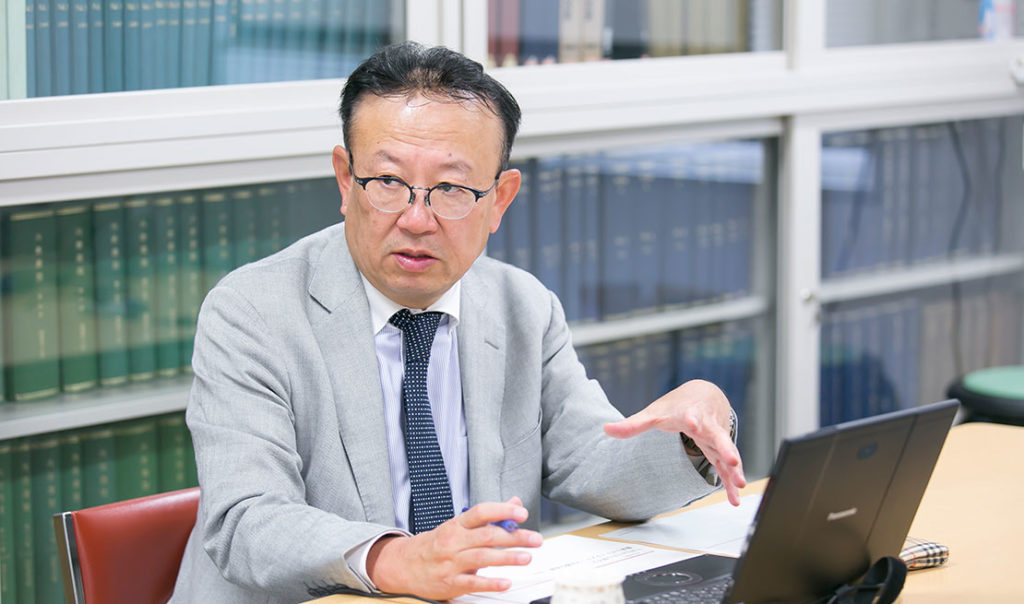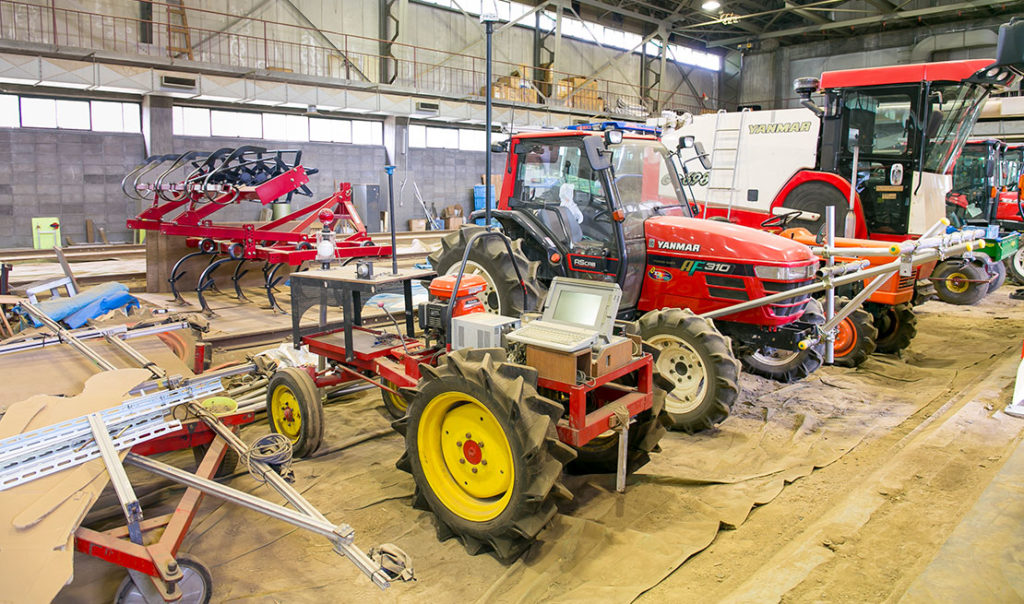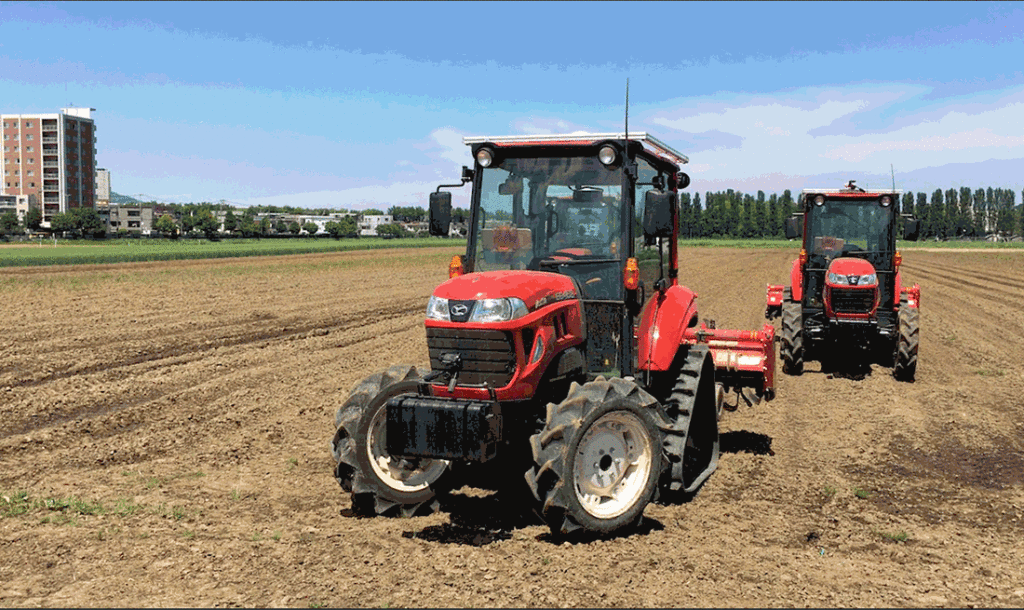The robots that we once saw only in animation and SF movies are now becoming more and more familiar in our daily lives. As robot research advances in areas that are familiar to us, such as automobiles and consumer electronics, our encounters with robots have increased. According to NEDO (New Energy and Industrial Technology Development Organization), the size of the robotics industry market in Japan is expected to expand significantly from 1.6 trillion JPY in 2015 to 2.9 trillion JPY in 2020, reaching 9.7 trillion JPY by the year 2035.
Against the background of this rapid expansion, there are social issues that are expected to be solved by robots, not to mention the evolution of technology. Population changes, food shortages due to climate change, labor shortages, etc., are common global areas of focus. Linked to the declining birthrate and aging population seen in Japan, agriculture, in which Yanmar is deeply involved, has similar challenges.
How can robots really change our lives? This time, we take a close-up look at agricultural robots. We talked to Professor Shin Noguchi of the Agricultural Research Institute, Hokkaido University Graduate School. Over the course of these two interviews, we’ll be bringing you with lots of information concerning past and present agricultural robot research, and what the future has in store.
 Shin Noguchi
Shin Noguchi
Professor Noguchi was born 1961 in Mikasa City, Hokkaido. He is a Professor at the Agricultural Research Institute of Hokkaido University’s Graduate School, specializing in Agricultural Information Technology and Agricultural Robotics Engineering. He is also the Program Director of the Cross-ministerial Strategic Innovation Promotion Program (SIP) “Next-Generation Agriculture, Forestry, and Fisheries Industry Creative Technology” and a Cooperating Member of the Science Council of Japan, Board Chairman of the Japanese Society of Agricultural, Biological and Environmental Engineers and Scientists.
Prototype No. 1: Self-assembled prototype built by collecting scrap materials from pneumatic tires to engines.
The homegrown beginnings of an agricultural robot

Professor Noguchi was born in Hokkaido, spending time in Yamaguchi prefecture until graduating from high school. He returned to Hokkaido upon entering the School of Agriculture at Hokkaido University. Majoring in agricultural engineering, he researched biomass fuels during his doctoral studies. As a university assistant in 1992, he started research in the field of agricultural robots. It was precisely at that time that the dawn of agricultural robot research emerged.
— Professor Noguchi, what was it that motivated you to begin robot research?
 Twenty-five years ago, when I started researching agricultural robots, the areas of focus concerning manpower and labor shortages in agriculture were already apparent. Here at Hokkaido University, the challenges directly facing agriculture are right in front of us. Attempting to resolve these issues led me to the idea that “maybe unmanned agricultural robots would be effective?”
Twenty-five years ago, when I started researching agricultural robots, the areas of focus concerning manpower and labor shortages in agriculture were already apparent. Here at Hokkaido University, the challenges directly facing agriculture are right in front of us. Attempting to resolve these issues led me to the idea that “maybe unmanned agricultural robots would be effective?”
Initially, there was very little research taking place. The Seiken Institute for Basic Technology Research (presently: Naro Bio-oriented Technology Research Advancement Institution, hereafter: “NARO”) was the only organization conducting research into autonomous guided vehicles for agriculture. I became affiliated there as an exchange researcher participating in the R&D projects.
— So, research began 25 years ago. What was it like at that time?
The first prototype we put it together from scrap materials, from pneumatic tires to sheet metal to the engine.
 Around 1992, some graduate students and myself built the first drone Prototype No. 1, which we put it together from scrap materials, from pneumatic tires to sheet metal to the engine. Although it was difficult to run, I wrote a paper from the various data collected from Prototype No. 1. The launch of the first full-blown agricultural robot was in 1995. This was after the procurement of tractor-type No. 2.
Around 1992, some graduate students and myself built the first drone Prototype No. 1, which we put it together from scrap materials, from pneumatic tires to sheet metal to the engine. Although it was difficult to run, I wrote a paper from the various data collected from Prototype No. 1. The launch of the first full-blown agricultural robot was in 1995. This was after the procurement of tractor-type No. 2.
Back in 1987–8, Kyoto University was at the center of activity when it began to develop harvester robots. At that time, agricultural robots were the mainstream for harvesting tomatoes and strawberries, etc., but agriculture in Hokkaido is mainly based on large-scale outdoor cultivation. Therefore, we fixed our sights on unmanned work.

— From the time you started your research, were you convinced that this technology would one day become essential?
 Yes, I was sure of it. The most difficult part of the development was the positional measurement and recognition of the drone. At that time, GPS wasn’t very accurate and it was also expensive. Therefore, we had to develop our own positional measurement system. However, in 1997, I participated in testing at the University of Illinois in America, where I saw autonomous driving in the natural environment using GPS performed with high accuracy and I thought, “This is good.” Naturally, the development of key technologies required for autonomous guidance, such as GPS and GIS (Global Information System), etc., was indispensable.The reality is, that our research depends on advances in many diverse fields.
Yes, I was sure of it. The most difficult part of the development was the positional measurement and recognition of the drone. At that time, GPS wasn’t very accurate and it was also expensive. Therefore, we had to develop our own positional measurement system. However, in 1997, I participated in testing at the University of Illinois in America, where I saw autonomous driving in the natural environment using GPS performed with high accuracy and I thought, “This is good.” Naturally, the development of key technologies required for autonomous guidance, such as GPS and GIS (Global Information System), etc., was indispensable.The reality is, that our research depends on advances in many diverse fields.
— As the agricultural population decreases, the area managed per farmer increases. The role played by drones is increasing.
 Exactly. The scale for rice farmers is presently about 12 hectares per capita with 20 hectares per two-person family. However, this will increase to about 30–40 hectares per family. As the transition to large scale farming progresses due to aspects of both the professional customer issues and economic efficiency, agricultural robots will become necessary to increase work efficiency and profitability.
Exactly. The scale for rice farmers is presently about 12 hectares per capita with 20 hectares per two-person family. However, this will increase to about 30–40 hectares per family. As the transition to large scale farming progresses due to aspects of both the professional customer issues and economic efficiency, agricultural robots will become necessary to increase work efficiency and profitability.
— Unmanned tractor verification testing is also progressing and is finally at the commercialization phase.
 The unmanned tractor, which has been researched and developed together with Yanmar, is a PC-controllable automatic guidance system that utilizes a tractor equipped with a GPS receiver. While running along a course that is preprogrammed from a tablet, etc., all work from tilling and sowing to harvesting can be performed unmanned.
The unmanned tractor, which has been researched and developed together with Yanmar, is a PC-controllable automatic guidance system that utilizes a tractor equipped with a GPS receiver. While running along a course that is preprogrammed from a tablet, etc., all work from tilling and sowing to harvesting can be performed unmanned.
There are a number of hurdles to negotiate to convert to fully unmanned. Firstly, to aim for practical realization, we achieved an accompanied-type manned and unmanned machine-type system. In a nutshell, if something happens, a person takes control; therefore, practical realization becomes possible. However, even at this point, you can simply expand the work area and sufficiently increase your productivity with two units sharing the work.
— We are looking forward to the response from the market. Are there any areas of focus at this present moment?
 Price and safety. From the cost aspect, the price of GPS, which cost 20 million JPY twenty years ago, has fallen. By 2020, we will be in an age where the anticipated price will be in the 100,000-JPY range. As technology progresses, it becomes easier for more people to obtain it.
Price and safety. From the cost aspect, the price of GPS, which cost 20 million JPY twenty years ago, has fallen. By 2020, we will be in an age where the anticipated price will be in the 100,000-JPY range. As technology progresses, it becomes easier for more people to obtain it.
However, safety is not an issue that can be simply resolved by technology. Zero risk is not possible if objects are man-made. Unmanned work on farming lands with unrestricted access can never be said to be 100% safe, regardless of how far safety is improved. For example, a child playing in the shadow of tall crops is difficult to identify by image processing. The issue of safety costs too much if we attempt to resolve it by technology alone. In the “Safety Guidelines for Automated Guidance Agricultural Machinery” drawn up by the Ministry of Agriculture, Forestry and Fisheries, it stipulates that a person must be present in places that can be monitored by visual contact. The accompanied type is one solution.
The aging population and worker shortage limit approaches
Agricultural robots improve productivity and tackle traditional skills succession

According to data from the Ministry of Agriculture , Forestry and Fisheries, aging has become a serious concern, with the average age of 65% of Japan’s agricultural workers being 66.8 years. The same Ministry has set targets to achieve commercialization by putting automated guidance of agricultural equipment in the field by 2018 and unmanned remote-monitored systems by 2020. Joint industry-government-academia technological developments are advancing.
— As for the future of agricultural robots, what type of scenario are you looking at?
 The government has also set targets to achieve unmanned remote monitoring systems by 2020. However, previous guidelines stipulate that “agricultural robots shall not run on roads.” Therefore, they will be very inefficient where the fields are separated. I think that traffic laws will have to be reviewed.
The government has also set targets to achieve unmanned remote monitoring systems by 2020. However, previous guidelines stipulate that “agricultural robots shall not run on roads.” Therefore, they will be very inefficient where the fields are separated. I think that traffic laws will have to be reviewed.
— Indeed, it appears that the way we work and how society works will have to change. What are your thoughts regarding the value of agricultural robots other than for labor replacement?
 As for their basic role, they will replace the labor force to supplement labor shortages. However, they will also be expected to fulfill a secondary role for the informatization of production sites. For example, the digitization of crop production sites. To this day, although farmers still make handwritten reports and must do administrative work, these tasks will become entirely digitized. The situation relies on everyone’s experience and intuition.
As for their basic role, they will replace the labor force to supplement labor shortages. However, they will also be expected to fulfill a secondary role for the informatization of production sites. For example, the digitization of crop production sites. To this day, although farmers still make handwritten reports and must do administrative work, these tasks will become entirely digitized. The situation relies on everyone’s experience and intuition.
Consequently, the disappearing wisdom of aging skilled farmers is a more serious issue than the labor shortage. If this wisdom is lost without being passed on, the efficiency and yield per unit area will decline as these people disappear. We could end up with an inefficient negative cycle.
In ten years’ time, people who are aged 65 years will be 75 years of age. We believe that the task of collecting and managing this nonverbalized “tacit knowledge,” which the individual agricultural worker possesses, and converting it into “explicit knowledge” is vital.
— What type of robots will be specifically useful for the informatization of production sites?
 The use of airborne drones is one example. Using drones or helicopters, we will be able to identify poor growth areas, yield variations, and so on, by sensing and photo shooting the field from the air. This will allow us to precisely control farmland based on this data. This is where work is also being done by Yanmar.
The use of airborne drones is one example. Using drones or helicopters, we will be able to identify poor growth areas, yield variations, and so on, by sensing and photo shooting the field from the air. This will allow us to precisely control farmland based on this data. This is where work is also being done by Yanmar.
However we look at it, the compatibility between robots and big data is very high. The farming lands and work data obtained by these kinds of tasks will, of course, be used by farmers. However, we believe that the next stage for unmanned working robots will be “robots that understand farming.” The robots will develop themselves by assimilating data, and this will be reflected in the work.
— More specifically, our impression is that agricultural robots will develop with AI.
 Really? Furthermore, it is likely that young, new agricultural workers—who have an interest in the introduction of these new technologies—will increase. I sense this every day with my students.
Really? Furthermore, it is likely that young, new agricultural workers—who have an interest in the introduction of these new technologies—will increase. I sense this every day with my students.
About 20 years ago, farmers would tell me “Our value adding work will disappear if drones are put to practical use.” However, by letting robots do the work they can do, this will allow humans to get on with the work that can only be done by humans. I believe robots will also be useful in the sense that farmers will be able to spend their time doing the creative value adding work, such as “what to grow and where to sell,” and “what to process.”
Agricultural robots will develop globally
Introducing technology that we expect to see in the future

— Agricultural areas of focus vary depending on the country. Can you show us the latest robots that are already in practical use or are being researched, including overseas technology, from Professor Noguchi’s viewpoint?
 Research is progressing, mainly in the home of large-scale farming in America and European countries, but also in China, South Korea, and Asian countries. In terms of labor shortages, the situation is the West is not as serious as it is in Japan. But, in all countries, the agricultural workforce is decreasing.
Research is progressing, mainly in the home of large-scale farming in America and European countries, but also in China, South Korea, and Asian countries. In terms of labor shortages, the situation is the West is not as serious as it is in Japan. But, in all countries, the agricultural workforce is decreasing.
The main concern is food shortage. The Food and Agricultural Organization of the United Nations (FAO) estimates that the global total population will reach 9.6 billion by the year 2050. To feed this population, we will have to double our food production. At the current rate, we will certainly run out of food.
One further area of focus is the increase in abnormal weather caused by climate change, such as intense downpours even in areas of low rainfall. Low precipitation is a premise of the traditional European agricultural model. Therefore, when it rains, large tractors become stuck and cannot be used. Accordingly, there are instances where it is not possible to complete seasonal work, and therefore the harvest yields will decrease. On the other hand, it’s not possible to hire more people to do this work with small tractors. Therefore, it is likely that unmanned tractors will attract more interest.
— Labor saving and streamlining seem to be common global areas of focus. So, let’s look at the agricultural robots that have caught the attention of Professor Noguchi.
Coordinated robots

At present, coordinated robots, such as the “multi-robot,” which we are developing in our laboratory, can be coordinated to run together in any number of units. Instead of enlarging individual drones, coordinating a multiplicity of drones is a new idea. Any number of units can be run together. This technology is slightly more advanced than the accompanied type that has been introduced to the market.
Note: Report covering a demonstration of coordinated robots at Hokkaido University. Enjoy Part 2!
Self-propelled strawberry harvester robot
The strawberry harvester robot, developed by Utsunomiya University and NARO, is a technology capable of harvesting without touching the fruit, based on relative color identification and accurate confirmation of the ripeness of the strawberry and its stem angle. Strawberries become damaged when touched by human hands. Therefore, this technology also has the advantage of not lowering the price of the product by not touching it. In terms of labor saving and improved productivity, running the robots at night allows personnel to check the unharvested fruit the following morning.
Power-Assist Suits
In agriculture, work is carried out on unstable soil rather than on hard surfaces. Therefore, this makes it extremely difficult to use humanoid robots. Although humanoid robots are not viable, power-assist suits have recently become popular. Equipped with electric motors, they make lifting work, etc., easy and have a unique appearance. In addition to carrying fruit and heavy crops, there’s a lot of anticipation regarding their application in nursing care fields. Commercialization has already started.
Autonomous screening-type weeding machines
From a lecture given by Professor Simon Blackmore of Harper Adams University, UK. An unmanned robot that removes weeds while avoiding crops. Although weeding between ridges is comparatively simple, weeding among crops is very difficult. The machine can be programmed to use a camera to identify the weeds. Robots that weed using lasers are also being researched and developed. The weeds will be burned off at the point of growth. Ultimately, herbicides may no longer be necessary.
This interview was brought to you by Professor Shin Noguchi, a leading researcher on agricultural robots. From Professor Noguchi’s involvement in this research, we can reaffirm the on-site necessity and the value that this research brings to agriculture and society.
This story will continue for some time to come. Next time, we’ll be reporting from the site where Professor Noguchi is conducting his verification tests. Also, we’ll also be talking about the future of agriculture that will be realized by agricultural robots.

























